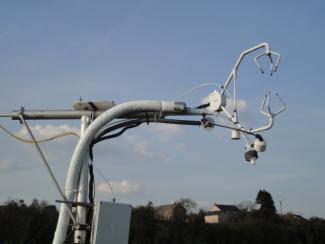Chemical composition and climate
Changes in the Earth system induced by human activities and their impact on life and natural environment are arguably the greatest environmental challenge facing us in the twenty- first century.
In order to inform decision makers on climate change mitigation and adaptation, a systematic monitoring of the global atmosphere and climate system is needed.
BIRA-IASB is involved in several important international programmes and projects, such as:
- ESA Climate Change Initiative (CCI)
- Copernicus Atmosphere Monitoring (CAMS)
- Climate Change Service (C3S)

We are proud to present a new introductory film, in which the Royal Belgian Institute is being presented in all its facets. Discover the many fields of research and societal challenges in which the Institute is active.
On January 31, King Philippe of Belgium visited the Space Pole and the Institute for Space Aeronomy. Scientists of BIRA-IASB presented him a glimpse of our climate, air quality and ozone layer research.
Contrarily to what was claimed a few years ago in a Nature paper, formaldehyde processing by liquid clouds cannot explain the large missing source of formic acid in the Earth's atmosphere.
Starting on Tuesday 27 June 2023, the European model which delivers our meteorological forecasts and monitors the global composition of the atmosphere will undergo a major upgrade.
Today, ACTRIS was established as a European Research Infrastructure Consortium for state-of-the-art data and services in atmospheric research.
From April 20 until June 25, an urban and contemporary art exhibition has opened in Ixelles, Brussels, inspired by science and with contributions from BIRA-IASB scientists.
A NASA Earth-observing satellite has helped researchers track carbon dioxide (CO2) emissions (sources) for more than 100 countries around the world.
On 29 November 2022 at 10 a.m., Secretary of State Thomas Dermine, Scientific Director Valérie Trouet and Operational Director Ella Jamsin officially opened the Climate Centre at the Space Pole in Uccle. Belgian and international scientific, industrial, academic, federal and political representatives attended this event. Bertrand Piccard, who flew around the world with the solar plane Solar Impulse, was the special guest.
On the occasion of the opening of the Federal Climate Centre, a call for artwork is being launched. It aims to announce the location of this new Climate Centre and build a bridge to the public space.
An international team of researchers shows that the Nyiragongo volcano (DR Congo) eruption (22 May 2021) could not have been predicted.
The Space Pole in Uccle opens its doors to the public on September 24 and 25, 2022.
This position statement on climate change was adopted by the Royal Belgian Institute for Space Aeronomy (BIRA-IASB) to clarify its ambition and its role in climate change research. It confirms the scientific basis for the consensus among Earth scientists that human activities are the primary cause of recent global warming, and that the provision, validation and interpretation of climate data records is part of the Institute’s missions.
In the new BBC documentary "Greta Thunberg: A Year to Change the World", Greta engaged in conversation with scientists all over the world, including the atmosphere and climate researcher Dr. Jenny Stavrakou of the Royal Belgian Institute for Space Aeronomy.
In the troposphere, the increase in carbon dioxide leads to a heating effect, while in the stratosphere and mesosphere, it causes a cooling effect.
BIRA-IASB researchers contributed to a study, lead by the ULB and the German FZJ, which finally sheds light on the formation mechanism of formic acid, a substance that has an impact on the acidity of the atmosphere and rainwater.
Scientists at the Royal Belgian Institute for Space Aeronomy (BIRA-IASB) have been closely involved in the analysis of the data and the techniques behind it, as well as in the quality control and scientific exploitation of the measurements. Enthusiastic about the results, they want to take this opportunity of “Three years TROPOMI” to provide more information about this satellite mission and to share their most appealing results.
BIRA-IASB is involved in the monitoring of volcanic and other stratospheric aerosols, delivering high quality data to centralised databases like the Copernicus programme, to be integrated in climatological models, among other things.
Trees emit isoprene, which strongly affects atmospheric chemistry and Earth's climate. BIRA-IASB scientists work on estimating how much isoprene is released, an important element in climate modelling and tackling climate change.
A BIRA-IASB scientist is among the 2% most cited researchers in the world, according to the Stanford international ranking. We interviewed Jean-François Müller about his life and career in scientific research.
Interview with BIRA-IASB scientist Alexis Merlaud, on an Antarctic expedition to measure aerosols at the Princess Elisabeth polar station.
The hole in the ozone layer above the Antarctic is very deep this year, due to the exceptionally cold temperatures in the stratosphere.
BIRA-IASB published an article in Nature Geoscience, presenting the first unambiguous detection of nitrous acid (HONO) from space, revealing the existence of enhanced HONO over wildfires.
An ICOS synthesis study describing the fingerprint of the 2018 summer drought in Europe trough measurements of CO2.
Is the sky clearer and bluer since the start of the lockdown? Where does the colour of the sky comes from?
Space-borne and ground-based instruments can detect such fires from space, as part of the Copernicus Earth Observation programme coordinated by the European Commission.
ICOS (Integrated Carbon Observation System) label for the Maïdo station on Reunion Island for BIRA-IASB.

